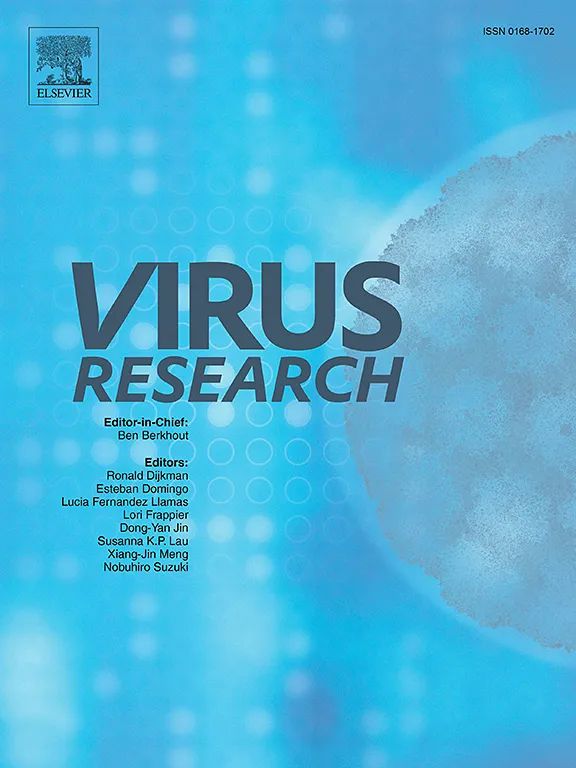猪G9P[23]轮状病毒与犬和大熊猫毒株相关基因片段的进化特征和致病性
IF 2.7
4区 医学
Q3 VIROLOGY
引用次数: 0
摘要
猪轮状病毒A (RVA)已成为一种越来越重要的人畜共患病原体,在包括人类在内的多种哺乳动物物种中引起严重的肠道疾病。在一次以腹泻感染哺乳仔猪的疫情中,发现了一种猪G9P[23]轮状病毒,命名为RVA/Pig-wt/China/ZJ03/2022/G9P[23](以下简称ZJ03)。为了进一步阐明ZJ03的进化多样性,我们对其所有基因组片段进行了综合分析。基因组群鉴定为G9-P[23]-I5-R1-C1-M1-A8-N1-T1-E1-H1。核苷酸序列鉴定和系统发育分析表明,ZJ03的VP3和NSP1基因分别与大熊猫品系和犬品系的对应基因亲缘关系最为密切,同源性最高,分别为95.73%和94.64%。其余基因与猪株的关系最为密切。最高同源度为95.98% ~ 99.49%。因此,有证据表明猪、犬和大熊猫轮状病毒毒株之间存在种间传播和基因重组事件。为了评估ZJ03菌株的致病性,我们实验用2 × 10^5.5 TCID50/ml /头仔猪口服接种ZJ03菌株感染3日龄仔猪。所有仔猪在感染后48小时出现严重腹泻,并伴有持续的病毒脱落和特征性的小肠绒毛萎缩,表明肠上皮受到严重损伤。在体外,ZJ03在MA104细胞中表现出高效的复制动力学,在感染后36小时达到峰值滴度10^9.25 TCID50/mL。本研究报告了中国大陆首次记录的新型猪G9P[23]轮状病毒,其基因片段与犬和大熊猫毒株相关,具有高病毒滴度和毒力的特点。这些发现强调了一种以前未记录的RVA菌株的出现,具有重要的病毒学和生态学意义。本文章由计算机程序翻译,如有差异,请以英文原文为准。
Evolutionary characterization and pathogenicity of a porcine G9P[23] rotavirus with gene segments linked to canine and giant panda strains
Porcine rotavirus A (RVA) has emerged as an increasingly consequential zoonotic pathogen, causing severe intestinal disorders across diverse mammalian species, including humans. During of an outbreak that struck nursing piglets with diarrhea, a porcine G9P[23] rotavirus, named as RVA/Pig-wt/China/ZJ03/2022/G9P[23] (hereafter referred to as ZJ03), was identified. To further elucidate the evolutionary diversity of ZJ03, a comprehensive analysis of all genome segments was conducted. The genome constellation was identified as G9-P[23]-I5-R1-C1-M1-A8-N1-T1-E1-H1. Nucleotide sequence identity and phylogenetic analyses indicated that the VP3 and NSP1 genes of ZJ03 are most closely related to the corresponding genes of the giant panda strain and the dog strain, respectively, showing the highest homology at 95.73 % identity and 94.64 %. The remaining genes demonstrated the most intimate relationship with porcine strains. Their highest homology levels ranged from 95.98 % to 99.49 % similarity. Therefore, evidence suggests interspecies transmission and genetic reassortment events between porcine, canine, and giant panda rotavirus strains. To evaluate the pathogenicity of ZJ03 strain, we experimentally infected 3-day-old piglets oral inoculation with the PoRV ZJ03 strain at a dose of 2 × 10^5.5 TCID50/ml per piglet. The infection resulted in severe diarrhea in all piglets, which occurred at 48 h post-infection (hpi), accompanied by sustained viral shedding and characteristic small intestinal villous atrophy, indicating significant damage to the intestinal epithelium. In vitro, ZJ03 exhibited efficient replication kinetics in MA104 cells, reaching peak titers of 10^9.25 TCID50/mL at 36 h post-infection. This study reports the first documented case of a novel porcine G9P[23] rotavirus with gene segments linked to canine and giant panda strains in mainland China, characterized by high viral titer and virulence. The findings highlight the emergence of a previously unrecorded RVA strain with significant virological and ecological implications.
求助全文
通过发布文献求助,成功后即可免费获取论文全文。
去求助
来源期刊

Virus research
医学-病毒学
CiteScore
9.50
自引率
2.00%
发文量
239
审稿时长
43 days
期刊介绍:
Virus Research provides a means of fast publication for original papers on fundamental research in virology. Contributions on new developments concerning virus structure, replication, pathogenesis and evolution are encouraged. These include reports describing virus morphology, the function and antigenic analysis of virus structural components, virus genome structure and expression, analysis on virus replication processes, virus evolution in connection with antiviral interventions, effects of viruses on their host cells, particularly on the immune system, and the pathogenesis of virus infections, including oncogene activation and transduction.
 求助内容:
求助内容: 应助结果提醒方式:
应助结果提醒方式:


